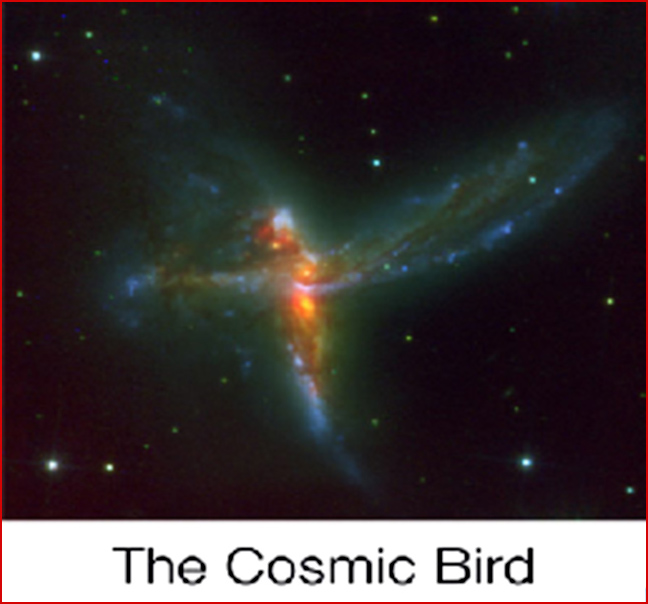
home •
about •
essential guide •
picture of the day •
thunderblogs •
news •
multimedia •
predictions •
products •
get involved •
contact
picture of the day archive subject index
A trio of interacting galaxies known as “The Bird”.
Credit: Henri Boffin European Space Agency (ESO)
Jun 10, 2008
The Bird is the Word"Do astronomers really prefer to elaborate obsolete theoretical assumptions rather than make new discoveries?" Halton Arp in Seeing Red.
This object - or these objects, depending on how you want to "see" (understand) them - lies west of the teapot's handle in the constellation of Sagittarius, at the edge of the Milky Way's central bulge. The object has been named The Bird because astronomers were looking for something familiar to see. If you're looking for tidal distortion, you'll see it. If you're looking for Birkeland current braiding, you'll see it.
The high redshift (z=0.049) means that the object (or objects) is 650 million light years away - if you believe (with the astronomical consensus) that redshift is proportional to distance. Or it means that the object is young - if you believe (with Halton Arp and collaborators) that redshift is proportional to age. Or it means that the object is the early stage of a plasma discharge instability - if you believe (with plasma cosmologists) that redshift is proportional to current density/electrical stress.
If it is far away and moving under gravitational forces alone, the object is giving off heat, radiating energy far in excess of what we know local matter can produce: It is an ultra-luminous infrared galaxy (ULIRG). If it's young and not so far away, it is again a ULIRG, but this time an under-luminous infrared galaxy. If a plasma discharge, it may be stupefyingly close.
It is on the outskirts of the "big zap" of the Milky Way's central plasmoid, where the driving Birkeland currents pinch down and current densities become unstable. (One might well recall Hannes Alfvén's description of the exploding rectifiers in the Swedish power transmission lines that filled the rectifier rooms with "fat sparks.") Because plasma instabilities tend to produce similar forms at all scales, plasma galaxies can be big or small, thousands of light years across or thousands of kilometers across.
The Bird could be merging galaxies in the middle distance of the universe, or it could be an unstable leakage current - flying sparks - from the core of the Milky Way. In daylight, with trees and buildings around, one still has difficulty judging the distance of a pinpoint of light. When staring into space in the blackness of midnight, one can only guess at the distance based on what one believes.
The limits of belief determine the limits of vision, and fervency separates the speculation that The Bird is far away from the speculation that it is within our own galaxy. Reasons and facts, excuses and analyses come afterward. The initial choice of belief emerges from an underlying attitude, either from allegiance to custom or from willingness to risk unconventional speculation in hopes of discovering a new world.
Space age instruments are looking at objects that customary beliefs did not expect to find. X-ray, radio, and infrared telescopes have given astronomers new eyes with which to look at the sky, but they still see with the old visions. The Bird challenges astronomers to adjust their attitudes, to be scientists instead of technicians and to become pioneers instead of apologists.
Contributed by Mel Acheson
___________________________________________________________________________Please visit our Forum
The Electric Sky and The Electric Universe available now!

|
|

|
EXECUTIVE EDITORS:
David Talbott, Wallace Thornhill
MANAGING EDITORS:
Steve Smith, Mel Acheson
CONTRIBUTING EDITORS: Michael Armstrong, Dwardu Cardona,
Ev Cochrane,
C.J. Ransom, Don Scott, Rens van der Sluijs, Ian Tresman
WEBMASTER: Brian Talbott
Copyright 2008: thunderbolts.info
![]()
home •
thunderblogs •
forum •
picture of the day •
resources •
team •
updates •
contact us

